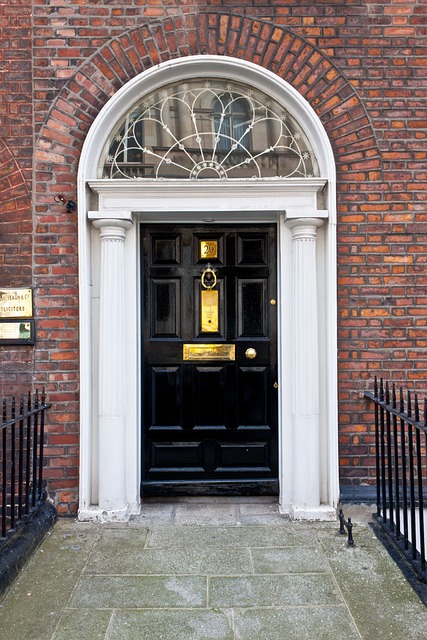Understanding local preservation guidelines is crucial for renovators and homeowners looking to restore historic homes while preserving their unique character and historical value, with a key focus on historic door refurbishment. This meticulous process involves assessing, documenting, and sourcing authentic components using traditional techniques and period-appropriate hardware. Adhering to region-specific standards from historical societies, conservation boards, and architectural heritage groups ensures structural integrity, visual appeal, and compliance with permits and regulations. The ultimate goal is to preserve the building's original integrity while allowing necessary updates for modern functionality.
“Unleash the beauty of the past with a comprehensive guide to navigating local preservation guidelines for historic homes and buildings. From understanding intricate regulations to mastering historic door refurbishment, this article is your key to success. Explore the significance of maintaining original features, learn best practices for door restoration, and discover how to seamlessly integrate modern needs while preserving history. Uncover the secrets to staying compliant, ensuring both the character and integrity of these timeless structures are preserved.”
Understanding Local Preservation Guidelines for Historic Homes
Understanding local preservation guidelines is crucial when undertaking any renovation or restoration work on historic homes. These guidelines are designed to protect and preserve the architectural integrity and historical value of older buildings, ensuring that any alterations respect the original design and character. For instance, in regions with a rich historical architecture, strict rules may govern the use of traditional building materials, specific preservation techniques for doors and windows (like historic door refurbishment), and even the color palettes allowed to maintain authenticity.
Renovators and homeowners must familiarize themselves with these local standards to ensure compliance. This involves researching and understanding the history of the area, the types of historical structures present, and the governing bodies responsible for preserving them. By adhering to these guidelines, historic homes can be restored while maintaining their unique character, ensuring they stand as testaments to the past for generations to come, showcasing the beauty of historic door refurbishment alongside other preserved features.
The Role of Historic Door Refurbishment in Compliance
The process of historic door refurbishment plays a pivotal role in ensuring compliance with local preservation guidelines and standards for historic homes and buildings. When restoring old doors, it’s crucial to accurately replicate the original design, materials, and craftsmanship that align with the era of the structure. This meticulous approach not only preserves the building’s historical integrity but also meets the stringent requirements set by preservation authorities.
Proper refurbishment involves careful assessment, documentation, and sourcing of authentic components. Craftspeople use traditional techniques and period-appropriate hardware to revive doors while maintaining their historical character. By adhering to these standards, property owners and builders contribute to the overall conservation of architectural heritage, ensuring that historic homes and buildings remain not just structurally sound but also faithful to their past.
Identifying Standards and Best Practices for Doors
When undertaking a historic door refurbishment, it’s essential to align your work with both local preservation guidelines and established best practices. The first step involves meticulously researching and identifying relevant standards specific to your region, as these regulations can vary widely depending on the area’s historical significance and cultural context. Local historical societies, conservation boards, and architectural heritage groups are invaluable resources for uncovering these guidelines, which often include specifications for materials, construction techniques, and aesthetic elements that preserve the building’s authenticity.
Best practices for historic door refurbishment emphasize respect for original features while ensuring functionality and safety. This might involve using period-appropriate hardware, such as brass or cast iron fixtures, and selecting wood types and finishes that mirror the building’s era. Expert restoration artisans play a crucial role in accurately recreating lost details or repairing worn elements, preserving the doors’ structural integrity while enhancing their visual appeal.
Navigating Permits and Regulations for Renovations
Navigating the world of permits and regulations can be a daunting task, especially when it comes to historic homes. For any renovation project on a building with historical significance, understanding and adhering to local preservation guidelines is paramount. This includes obtaining the necessary permits, which often require detailed plans and approval from relevant historical societies or authorities.
When undertaking a historic door refurbishment, for instance, homeowners must ensure they comply with local laws. This may involve submitting blueprints, specifying the use of period-appropriate materials, and even preserving original hardware. The process requires careful documentation and respect for the building’s history, ensuring that any changes maintain its integrity while allowing for necessary updates.
Preserving the Character and Integrity of Historic Buildings
The character and integrity of historic buildings are paramount in their preservation. This includes maintaining the original architectural details, such as windows, doors, and trim, which contribute to the building’s historical significance and aesthetic appeal. In the case of historic door refurbishment, it involves carefully restoring or replacing doors to match the period and style of the structure. Craftspeople use traditional techniques and materials to ensure the doors not only function properly but also remain faithful to the building’s original design.
Preservation guidelines emphasize the importance of avoiding alterations that could compromise the building’s historical integrity. This means using appropriate, period-correct fixtures and hardware during refurbishment projects. By adhering to these standards, owners of historic homes can enhance the building’s value and ensure its longevity while preserving its unique character for future generations to appreciate.
Compliance with local preservation guidelines is key to ensuring that historic homes and buildings maintain their character and integrity. By understanding these guidelines, adopting best practices for elements like historic door refurbishment, and navigating permits and regulations thoughtfully, we can preserve these architectural treasures for future generations. This not only protects our cultural heritage but also enhances the value and appeal of these iconic structures in today’s world.
